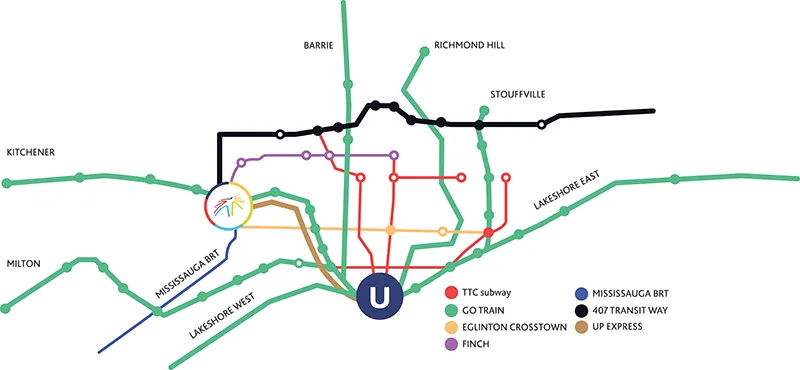Keeping Canada moving
A second major transit hub at Toronto Pearson will relieve congestion and give residents transit access to new employment areas in the GTHA. supplied
Toronto Pearson aims to eliminate bottlenecks in the airport and the region
Maintaining Toronto Pearson International Airport’s megahub status and continuing to keep customers happy means that, as the airport operator, the Greater Toronto Airports Authority (GTAA) must constantly strive to improve infrastructure and services in and around the facility.
For example, there is currently a strong focus on moving people, not only within the airport, but also to and from it. Traffic congestion in the Greater Toronto Area (GTA) is a growing problem. Driving times to Toronto Pearson are expected to rise by an average of 30 per cent in the next 20 years, and GTAA president and CEO Howard Eng wants to do something about it.
“Road congestion is affecting our region’s ability to attract investment, and also impacting quality of life for area residents,” he says. “We’re committed to working with the municipalities surrounding the airport, area employers and industry groups to improve ground transit in the airport area. Our vision for a Regional Transit and Passenger Centre at Toronto Pearson will help to reduce congestion in the area, lower costs for industry and improve productivity for local business.”
To this end, the GTAA and Metrolinx earlier this year announced that they will be working together to study potential connections for the Kitchener rail corridor to Toronto Pearson’s Regional Transit and Passenger Centre, in addition to other potential transit connections such as the Eglinton Crosstown West Light Rail Transit (LRT). This advancement of work to better integrate transit projects into Canada’s busiest airport will help connect the country’s second largest employment zone and reduce highway congestion.
Further toward the objective of better connecting people, Toronto Pearson is also a member of the Southern Ontario Airport Network, a group of 11 airports that is taking a bigger picture view of what is in store for southern Ontario, identifying synergistic business opportunities and enhancing air transportation service and capacity as a group rather than on an airport-by-airport basis. In this way, the region will be positioned to meet future growth in air travel demand, ensuring the benefits of air connectivity are not lost to other regions better prepared to handle the growth.
“Toronto Pearson must provide
travellers a timely, efficient and
consistent experience to stay globally competitive.”
Keeping passengers moving within the airport is an equally pressing challenge for the GTAA. Mr. Eng says too many travellers are waiting too long for pre-board security screening and customs at Toronto Pearson during peak times, which results in flight delays, cancellations, missed connections and loss of connections to other competing U.S. airports.
“Toronto Pearson must provide travellers a timely, efficient and consistent experience to stay globally competitive,” he adds.
With additional resources, the two key Canadian government agencies responsible for security screening and customs processing at Toronto Pearson – the Canadian Air Transport Security Authority (CATSA) and the Canadian Border Services Agency – could have a demonstrably positive impact on reducing passenger lineups and wait times, says Mr. Eng.
He points out that Canada’s aviation industry supports a shared goal of having 95 per cent of passengers screened in 10 minutes or less, with no passenger waiting longer than 20 minutes. In 2017, 19.4 million passengers were screened by CATSA at Toronto Pearson, one-third screened at morning and afternoon peak times waited longer than 10 minutes – and in some cases longer than 60 minutes.
Perrin Beatty, president and CEO of the Canadian Chamber of Commerce, underscores that more efficiently moving people at and around Toronto Pearson is vital to Canada’s prosperity.
“An investment in making Pearson more competitive – whether by improving security wait times or by better connecting the airport to the communities it serves through enhanced transit links – is an investment in our collective future. Ensuring travellers and goods can move more easily to and through Toronto Pearson will strengthen Canada’s success in the global economy,” he adds.
Jan De Silva, president and CEO of the Toronto Region Board of Trade, agrees.
“Pearson Airport is more than a staging point for the departure and arrival of people and goods. It is a strategic economic infrastructure asset providing business travellers and their goods access to domestic and global markets,” she says. “Improving the movement of goods, passengers and workers, and building connectivity through the Pearson transit centre and harmonizing security screening with an internationally competitive service standard, will solidify Toronto’s position as a global business hub. Enhancing the competitiveness of our airports is the price of admission to the global economy.”
To view more stories related to this article visit globeandmail.com

